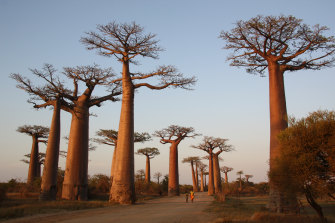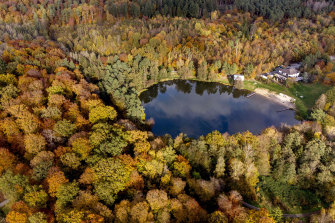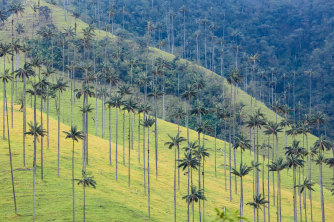After counting Earth’s trees, scientists say thousands more species to be discovered

Washington: From the monkey puzzle tree of Peru to the Tasmanian blue gum of Australia, from the baobabs of Madagascar to the giant sequoias of California, the world is blessed with an abundance of tree species. How many? A new study has the answer.
Researchers have unveiled the world’s largest forest database, comprising more than 44 million individual trees at more than 100,000 sites in 90 countries – helping them to calculate that Earth boasts roughly 73,300 tree species.
Baobab trees in Madagascar. Credit:Louise Southerden
That figure is about 14 per cent higher than previous estimates. Of that total, about 9200 are estimated to exist based on statistical modelling but have not yet been identified by science, with a large proportion of these growing in South America, the researchers said.
South America, home to the enormously biodiverse Amazon rainforest and farflung Andean forests, was found to harbour 43 per cent of the planet’s tree species and the largest number of rare species, at about 8200.
Trees and forests are much more than mere oxygen producers, said Roberto Cazzolla Gatti, a professor of biological diversity and conservation at the University of Bologna in Italy and lead author of the study published in the journal Proceedings of the National Academy of Sciences.
“Without trees and forests, we would not have clean water, safe mountain slopes, habitat for many animals, fungi and other plants, the most biodiverse terrestrial ecosystems, sinks for our excess of carbon dioxide, depurators of our polluted air, et cetera,” Gatti said.
Colorful trees surround the small Hattstein lake in Usingen in the Taunus region near Frankfurt, Germany.Credit:AP
“Indeed, our society often considers forests as just pieces of wood and trees as natural resources, ignoring their fundamental role for humankind in providing ecosystem services that go behind the mere economic – even if important – timber, paper and pulp production. From trees and forests humanity gets inspiration, relaxation, spirituality and essentially the meaning of life,” Gatti added.
South America was found to have about 27,000 known tree species and 4000 yet to be identified. Eurasia has 14,000 known species and 2000 unknown, followed by Africa (10,000 known/1000 unknown), North America including Central America (9000 known/2000 unknown) and Oceania including Australia (7000 known/2000 unknown).
“By establishing a quantitative benchmark, our study can contribute to tree and forest conservation efforts,” said study co-author Peter Reich, a forest ecologist at the University of Michigan and University of Minnesota.
“This information is important because tree species are going extinct due to deforestation and climate change, and understanding the value of that diversity requires us to know what is there in the first place before we lose it,” Reich said. “Tree species diversity is key to maintaining healthy, productive forests, and important to the global economy and to nature.”
The Quindío wax palm, the world’s tallest palm, which grows in the Andes where scientists say there are thousands more as yet undiscovered tree species. Credit:Getty
This study did not tally the total number of individual trees globally, but 2015 research led by one of the co-authors put that figure at about 3 trillion.
The new study pinpointed global tree diversity hot spots in the tropics and subtropics in South America, Central America, Africa, Asia and Oceania. It also determined that about a third of known species can be classified as rare.
The researchers used methods developed by statisticians and mathematicians to estimate the number of unknown species based on the abundance and presence of known species. Tropical and subtropical ecosystems in South America may nurture 40 per cent of these yet-to-be-identified species, they said.
“This study reminds us how little we know about our own planet and its biosphere,” said study co-author Jingjing Liang, a professor of quantitative forest ecology at Purdue University in Indiana. “There is so much more we need to learn about the Earth so that we can better protect it and conserve natural resources for future generations.”
AP
Most Viewed in World
From our partners
Source: Read Full Article



